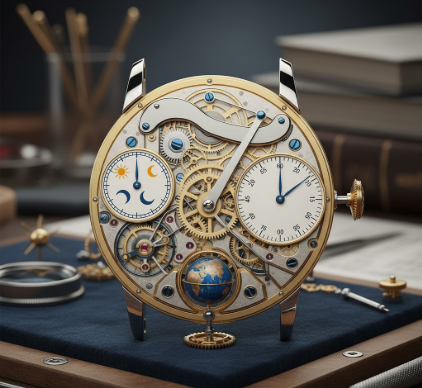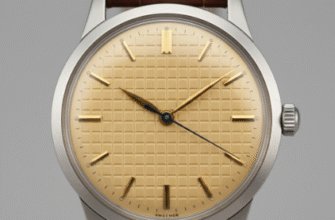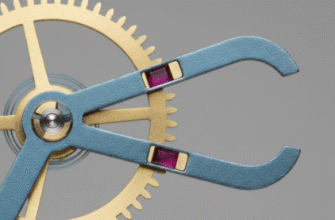For the dedicated horological and astronomical enthusiast, few mechanical feats are as intellectually satisfying as the equation of time. It is a complication that transcends mere time-telling, serving as a tangible, miniature model of our planet’s celestial dance. Unlike a tourbillon, designed to counteract a now-obsolete problem, or a minute repeater, which offers an audible convenience, the equation of time is pure astronomical poetry. It connects the steady, averaged beat of our watches—our civilized, mean solar time—to the dynamic, ever-changing reality of the Sun’s actual position in the sky, known as apparent solar time. It is the bridge between human-regulated time and cosmic time.
The fundamental question it answers is simple: If you were to check your highly accurate mechanical watch at the precise moment a sundial shows high noon (the Sun at its zenith), what would your watch read? The answer is rarely 12:00 PM. Throughout the year, clock time can be ahead of sundial time by as much as 16 minutes and 33 seconds (around November 3rd) or behind by as much as 14 minutes and 6 seconds (around February 12th). This discrepancy, the difference between apparent and mean solar time, is the equation of time. Only four times a year—around April 15th, June 13th, September 1st, and December 25th—do the two times align.
The Celestial Mechanics Behind the Discrepancy
To truly appreciate the mechanical ingenuity required to display the equation of time on a watch dial, one must first grasp the two primary astronomical phenomena responsible for it. These are not flaws in our timekeeping but fundamental properties of the Earth’s orbit and orientation. They work in concert to create the complex, non-linear pattern of deviation that horologists have sought to capture mechanically.
Component One: Orbital Eccentricity
The first contributor is the
eccentricity of the Earth’s orbit. Our planet does not travel around the Sun in a perfect circle, but rather in a slight ellipse. The Sun is not at the center of this ellipse but at one of its two foci. Consequently, the distance between the Earth and the Sun varies throughout the year. Around January 3rd, the Earth reaches
perihelion, its closest point to the Sun, and moves at its fastest orbital speed. Around July 4th, it reaches
aphelion, its farthest point, and moves at its slowest. This is a direct consequence of Kepler’s Second Law of Planetary Motion, which states that a line segment joining a planet and the Sun sweeps out equal areas during equal intervals of time. Because our 24-hour day is an average based on the Earth completing a full 360-degree rotation, this variation in orbital speed causes the apparent solar day (the time from one solar noon to the next) to be slightly longer near perihelion and slightly shorter near aphelion than our standardized 24-hour mean day. This effect, on its own, would create a simple sine-wave-like deviation over the year.
Component Two: Axial Tilt (Obliquity of the Ecliptic)
The second, and more significant, contributor is the Earth’s
axial tilt, also known as the obliquity of the ecliptic. The Earth’s rotational axis is not perpendicular to its orbital plane; it is tilted at an angle of approximately 23.45 degrees. We perceive this as the Sun tracing a path across the sky called the ecliptic, which is inclined relative to our celestial equator. Our mean solar day, however, is based on a fictional “mean Sun” that travels at a constant speed along the celestial equator. The problem arises when projecting the Sun’s actual movement along the angled ecliptic onto the flat plane of the celestial equator. Even if the Earth’s orbit were a perfect circle, this projection effect alone would cause a discrepancy. At the solstices, the Sun’s apparent motion is mostly parallel to the celestial equator, so its eastward progress (which defines the length of the day) is at its maximum. At the equinoxes, its path is most sharply angled relative to the equator, so its eastward progress is less. This creates a double sine-wave deviation over the course of a year, with two positive and two negative peaks.
The equation of time is the sum of two distinct astronomical effects. The first is the Earth’s elliptical orbit, which causes its orbital speed to vary, making apparent solar days longer in winter and shorter in summer (in the Northern Hemisphere). The second is the Earth’s axial tilt, which causes the Sun’s projected speed across the celestial equator to vary. The combination of these two sine-like curves—one with a period of one year (from eccentricity) and one with a period of six months (from obliquity)—results in the complex, asymmetrical pattern known as the analemma.
When these two effects are combined, they produce the famous figure-8 curve known as the
analemma, which you might see printed on old globes. This shape graphically represents the equation of time, plotting the Sun’s declination against the difference between apparent and mean solar time for every day of the year. It is this complex, beautiful curve that watchmakers must mechanically replicate.
Mechanizing the Analemma: The Watchmaker’s Challenge
The transition from sundials to mechanical clocks in the late Middle Ages created the very problem the equation of time complication solves. Clocks run at a constant, unvarying rate, offering a convenience and regularity that nature does not. For centuries, astronomers and navigators relied on tables and charts to convert between clock time and sundial time. The idea of building a mechanism that could perform this calculation automatically was a horological holy grail. The challenge was immense: how to translate a complex, non-linear astronomical cycle into a reliable, miniature mechanical system.
The Kidney Cam and Follower System
The most common and enduring solution is a system based on a precisely shaped cam. At the heart of the mechanism is a flat metal disc, known as the
equation cam or “kidney,” that rotates just once per year. The perimeter of this cam is not circular; its radius varies continuously, physically mapping the values of the equation of time for every day of the year. Its shape is essentially the analemma curve unwrapped and plotted radially.
A mobile lever or finger, known as a
follower or “feeler,” rests against the edge of this cam. As the cam slowly rotates over 365.25 days, the follower is pushed outward or allowed to move inward, precisely tracing the shape of the cam. The movement of this follower is then transmitted through a series of racks and gears to an indicator on the watch dial. Typically, this is a hand on a small sub-dial or sector, marked with a scale from approximately -16 to +14 minutes. The wearer can then see the current deviation and manually calculate apparent solar time by adding or subtracting the value from the main time display. This is the most direct and common implementation of the complication.
The Ultimate Expression: The Equation Marchante
A far more complex, rare, and elegant solution is the
équation marchante, or “running equation.” This system, perfected by the great Abraham-Louis Breguet, does not merely display the difference to be calculated; it displays apparent solar time directly. It achieves this with the use of two concentric minute hands on the central axis.
One hand is the traditional mean time minute hand, which moves at a constant rate. The second hand is the apparent solar time minute hand. The equation cam and follower system are still present, but instead of driving a small indicator on a sector, its motion is transmitted to a differential gear system. This clever system continuously modifies the position of the solar minute hand relative to the mean minute hand. On days when apparent time is ahead of mean time, the solar hand will run slightly ahead of the regular minute hand on the dial. On days when it is behind, it will lag. The two hands will meet and overlap precisely on the four days of the year when the equation of time is zero. This provides an immediate, intuitive visual representation of both time systems simultaneously, a true mechanical marvel and the pinnacle of this esoteric art.









